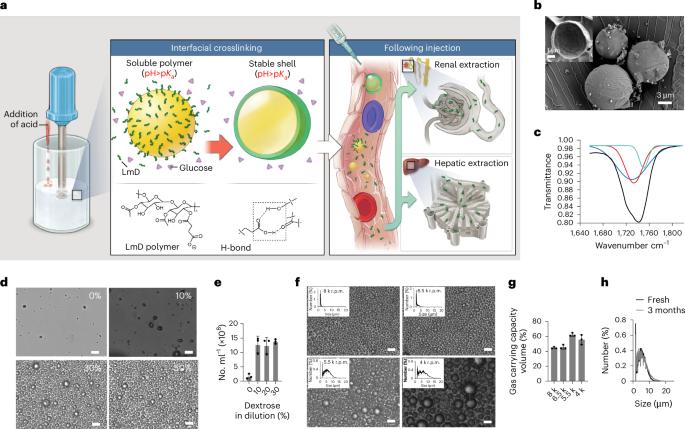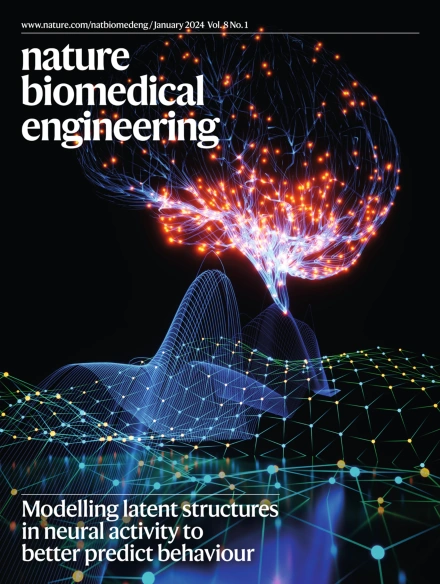Systemically injected oxygen within rapidly dissolving microbubbles improves the outcomes of severe hypoxaemia in swine
IF 26.8
1区 医学
Q1 ENGINEERING, BIOMEDICAL
引用次数: 0
Abstract
Acute respiratory failure can cause profound hypoxaemia that leads to organ injury or death within minutes. When conventional interventions are ineffective, the intravenous administration of oxygen can rescue patients from severe hypoxaemia, but at the risk of microvascular obstruction and of toxicity of the carrier material. Here we describe polymeric microbubbles as carriers of high volumes of oxygen (350–500 ml of oxygen per litre of foam) that are stable in storage yet quickly dissolve following intravenous injection, reverting to their soluble and excretable molecular constituents. In swine with profound hypoxaemia owing to acute and temporary (12 min) upper-airway obstruction, the microbubble-mediated delivery of oxygen led to: the maintenance of critical oxygenation, lowered burdens of cardiac arrest, improved survival, and substantially improved neurologic and kidney function in surviving animals. Our findings underscore the importance of maintaining a critical threshold of oxygenation and the promise of injectable oxygen as a viable therapy in acute and temporary hypoxaemic crises. The intravenous injection of oxygen via polymeric microbubbles that are stable in storage yet quickly dissolve following intravenous injection led to the maintenance of critical oxygenation and to improved survival in swine with profound hypoxaemia.


在快速溶解的微气泡内全身注射氧气可改善猪严重低氧血症的治疗效果
急性呼吸衰竭可导致严重低氧血症,并在数分钟内导致器官损伤或死亡。当常规干预措施无效时,静脉注射氧气可将患者从严重的低氧血症中解救出来,但存在微血管阻塞和载体材料中毒的风险。在这里,我们描述了聚合物微气泡作为大容量氧气(每升泡沫中含有 350-500 毫升氧气)的载体,它在储存过程中非常稳定,但在静脉注射后会迅速溶解,恢复成可溶解和可排泄的分子成分。在因急性和暂时性(12 分钟)上气道阻塞而出现严重低氧血症的猪身上,微气泡介导的氧气输送可:维持临界氧饱和度、降低心脏骤停的负担、提高存活率以及显著改善存活动物的神经和肾功能。我们的研究结果强调了维持临界氧合阈值的重要性,以及注射氧作为急性和暂时性低氧血症危机的可行疗法的前景。
本文章由计算机程序翻译,如有差异,请以英文原文为准。
求助全文
约1分钟内获得全文
求助全文
来源期刊

Nature Biomedical Engineering
Medicine-Medicine (miscellaneous)
CiteScore
45.30
自引率
1.10%
发文量
138
期刊介绍:
Nature Biomedical Engineering is an online-only monthly journal that was launched in January 2017. It aims to publish original research, reviews, and commentary focusing on applied biomedicine and health technology. The journal targets a diverse audience, including life scientists who are involved in developing experimental or computational systems and methods to enhance our understanding of human physiology. It also covers biomedical researchers and engineers who are engaged in designing or optimizing therapies, assays, devices, or procedures for diagnosing or treating diseases. Additionally, clinicians, who make use of research outputs to evaluate patient health or administer therapy in various clinical settings and healthcare contexts, are also part of the target audience.
 求助内容:
求助内容: 应助结果提醒方式:
应助结果提醒方式:


